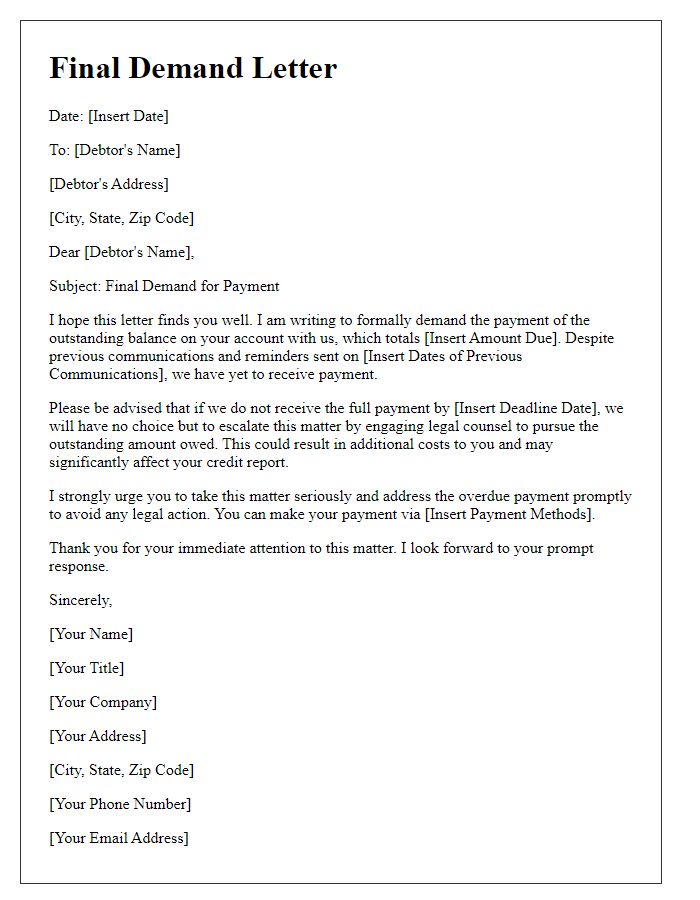Are you facing the tough task of drafting a final notice before taking legal action? It's essential to communicate clearly and professionally, ensuring that your message conveys urgency without compromising tone. This template will help you outline key details, such as outstanding balances and potential consequences of inaction, all while maintaining a dialogue. If you're looking for guidance on how to effectively express your intentions, keep reading for valuable insights.

Clear identification of parties involved
A final notice before legal action serves as a crucial step in the dispute resolution process between two parties in a legal context. The primary parties typically include the claimant (individual or entity seeking resolution) and the respondent (individual or entity being addressed). Clear identification involves stating the full legal names, business designations (if applicable), and addresses of both the claimant and respondent. For example, if a small business, such as "ABC Supplies LLC," based in New York City (123 Main St, New York, NY 10001), is pursuing action against an individual named "John Doe," residing at 456 Elm St, Brooklyn, NY 11201, this information must be clearly delineated in the notice. This identification not only clarifies the involved parties but also supports the legal validity of the notice as it outlines who is responsible and provides a clear framework for proceeding with potential legal actions, such as filing a lawsuit or seeking mediation.
Statement of outstanding obligation or issue
Final notices regarding outstanding obligations require clear articulation of the debt amount, dates due, and the consequences of non-payment. For example, a tenant who owes $2,500 in rent since March 1, 2023, must be informed of the impending legal action if the payment is not made by the specified deadline, October 31, 2023. In this notice, details about the lease agreement's terms must be included, specifically referencing the clause that outlines eviction procedures in case of non-compliance. Additionally, contact information for the property management company, such as Phone: (555) 123-4567, should be present to facilitate direct communication for resolution before escalating to legal proceedings.
Consequences of non-compliance
Final notices before legal actions serve as critical communications regarding non-compliance with contractual obligations or legal requirements, often indicating potential consequences. Entities such as companies, tenants, or individuals may receive these notices when they fail to adhere to payment terms, property maintenance responsibilities, or regulatory statutes. Legal action, resulting in court proceedings, could lead to monetary damages, repossession of assets, or penalties enforced by authorities. Compliance with stated demands, which may include overdue payments, necessary repairs, or other stipulated actions, is essential to avoid escalation to formal litigation processes, ultimately preserving both financial stability and legal standing.
Deadline for resolution or response
Failure to address outstanding debts can lead to legal consequences. Final notice letters typically specify a deadline for resolution, commonly set at 14 days from the date of issuance. These letters serve as a formal warning, highlighting the creditor's intention to pursue legal action if no response is provided. Recipients should take note of the specific amount owed, which could include principal debt, interest, and additional fees. Locations for potential court filings may include local civil courts, depending on jurisdictional regulations. The document must clearly outline methods for contact and payment remittance to facilitate resolution.
Contact information for further communication
In the realm of debt collection, a final notice serves as a critical communication tool before escalating to legal action. It typically includes essential contact information such as the creditor's official address, phone numbers, and email for immediate correspondence. Clarity in these details is paramount, facilitating direct dialogue between the parties involved and potentially preventing costly court proceedings. Documentation of previous communications highlights the urgency and seriousness of the matter while offering a last opportunity for resolution. Legal representatives may also be listed to guide the debtor in understanding their rights and responsibilities under applicable laws. Prompt attention to this notice can lead to alternative dispute resolutions, safeguarding both parties' interests.













Comments